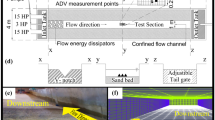Abstract
River bank erosion due to unstable banks and high flow variability is usually controlled using permeable and impermeable structures, which are not studied much yet and also cannot solely provide desired velocity reduction. These structures, along with a combination of porcupine screens followed by geobag (i.e., Hybrid layout), are investigated using CCHE3D model for emerged, transition, and submerged flow conditions with respect to porcupine height. An optimum hybrid layout showed velocity reductions of 35% in submerged and 70% in emerged conditions, which further increased with multiple porcupine screens.
Access this chapter
Tax calculation will be finalised at checkout
Purchases are for personal use only
Similar content being viewed by others
References
Aamir M, Sharma N (2015) Riverbank protection with Porcupine systems: development of rational design methodology. ISH J Hydraulic Eng 317–332
Julien PY (2002) River mechanics. Cambridge University Press, Cambridge, U.K.
Sarker MH, Akter J, Ferdous MR (2011) River bank protection measures in the Brahmaputra-Jamuna River: Bangladesh Experience. International Seminar on ’River, Society and Sustainable Development, Dibrugarh
Yoo KH (2003) Nature friendly River Training Structure using Groynes. Water Resources Research Department, Korean Institute of Construction Technology, Korea.
Zhang Y, Jia Y (2009) CCHE-MESH: 2D structured mesh generator user’s manual-version 3.x. School of Engineering, The University of Mississippi, Mississippi
Author information
Authors and Affiliations
Corresponding author
Editor information
Editors and Affiliations
Rights and permissions
Copyright information
© 2022 The Author(s), under exclusive license to Springer Nature Switzerland AG
About this chapter
Cite this chapter
Kakati, R., Chembolu, V., Dutta, S. (2022). 3D Modelling of Hybrid River Training Works. In: Jha, R., Singh, V.P., Singh, V., Roy, L.B., Thendiyath, R. (eds) River Hydraulics. Water Science and Technology Library, vol 110. Springer, Cham. https://doi.org/10.1007/978-3-030-81768-8_31
Download citation
DOI: https://doi.org/10.1007/978-3-030-81768-8_31
Published:
Publisher Name: Springer, Cham
Print ISBN: 978-3-030-81767-1
Online ISBN: 978-3-030-81768-8
eBook Packages: Earth and Environmental ScienceEarth and Environmental Science (R0)




